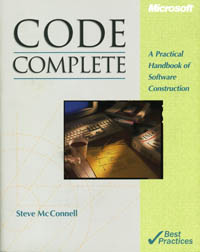Related Research Articles
Computer programming or coding is the composition of sequences of instructions, called programs, that computers can follow to perform tasks. It involves designing and implementing algorithms, step-by-step specifications of procedures, by writing code in one or more programming languages. Programmers typically use high-level programming languages that are more easily intelligible to humans than machine code, which is directly executed by the central processing unit. Proficient programming usually requires expertise in several different subjects, including knowledge of the application domain, details of programming languages and generic code libraries, specialized algorithms, and formal logic.
In computer programming and software design, code refactoring is the process of restructuring existing computer code—changing the factoring—without changing its external behavior. Refactoring is intended to improve the design, structure, and/or implementation of the software, while preserving its functionality. Potential advantages of refactoring may include improved code readability and reduced complexity; these can improve the source code's maintainability and create a simpler, cleaner, or more expressive internal architecture or object model to improve extensibility. Another potential goal for refactoring is improved performance; software engineers face an ongoing challenge to write programs that perform faster or use less memory.
Software engineering is an engineering approach to software development. A practitioner, a software engineer, applies the engineering design process to develop software.

Software testing is the act of checking whether software satisfies expectations.
A software bug is bug in computer software.
Regression testing is re-running functional and non-functional tests to ensure that previously developed and tested software still performs as expected after a change. If not, that would be called a regression.
In computing and computer programming, exception handling is the process of responding to the occurrence of exceptions – anomalous or exceptional conditions requiring special processing – during the execution of a program. In general, an exception breaks the normal flow of execution and executes a pre-registered exception handler; the details of how this is done depend on whether it is a hardware or software exception and how the software exception is implemented.
Test-driven development (TDD) is a way of writing code that involves writing an automated unit-level test case that fails, then writing just enough code to make the test pass, then refactoring both the test code and the production code, then repeating with another new test case.
Code review is a software quality assurance activity in which one or more people check a program, mainly by viewing and reading parts of its source code, either after implementation or as an interruption of implementation. At least one of the persons must not have authored the code. The persons performing the checking, excluding the author, are called "reviewers".

Code Complete is a software development book, written by Steve McConnell and published in 1993 by Microsoft Press, encouraging developers to continue past code-and-fix programming and the big design up front and waterfall models. It is also a compendium of software construction techniques, which include techniques from naming variables to deciding when to write a subroutine.
Software verification is a discipline of software engineering, programming languages, and theory of computation whose goal is to assure that software satisfies the expected requirements.
Software maintenance in software engineering is the modification of a software product after delivery to correct faults, to improve performance or other attributes.
In software testing, test automation is the use of software separate from the software being tested to control the execution of tests and the comparison of actual outcomes with predicted outcomes. Test automation can automate some repetitive but necessary tasks in a formalized testing process already in place, or perform additional testing that would be difficult to do manually. Test automation is critical for continuous delivery and continuous testing.
A Fagan inspection is a process of trying to find defects in documents during various phases of the software development process. It is named after Michael Fagan, who is credited with the invention of formal software inspections.
A software review is "a process or meeting during which a software product is examined by a project personnel, managers, users, customers, user representatives, or other interested parties for comment or approval".
Coding best practices or programming best practices are a set of informal, sometimes personal, rules that many software developers, in computer programming follow to improve software quality. Many computer programs require being robust and reliable for long periods of time, so any rules need to facilitate both initial development and subsequent maintenance of source code by people other than the original authors.
Software security assurance is a process that helps design and implement software that protects the data and resources contained in and controlled by that software. Software is itself a resource and thus must be afforded appropriate security.
Frame technology (FT) is a language-neutral system that manufactures custom software from reusable, machine-adaptable building blocks, called frames. FT is used to reduce the time, effort, and errors involved in the design, construction, and evolution of large, complex software systems. Fundamental to FT is its ability to stop the proliferation of similar but subtly different components, an issue plaguing software engineering, for which programming language constructs or add-in techniques such as macros and generators failed to provide a practical, scalable solution.
Development testing is a software development process that involves synchronized application of a broad spectrum of defect prevention and detection strategies in order to reduce software development risks, time, and costs.
This article discusses a set of tactics useful in software testing. It is intended as a comprehensive list of tactical approaches to Software Quality Assurance (more widely colloquially known as Quality Assurance and general application of the test method.
References
- Pierre Bourque; Richard E. Fairley, eds. (2014). "Chapter 3: Software Construction". Guide to the Software Engineering Body of Knowledge Version 3.0. IEEE Computer Society. ISBN 978-0-7695-5166-1.
- McConnell, Steven (2004). Code Complete (2nd ed.). Microsoft Press. ISBN 978-0-7356-1967-8.
- Thayer, Richard; Dorfman, Merlin (2013). Software Engineering Essentials. Vol. I: The Development Process (Fourth ed.). Software Management Training Press, Carmichael, California. ISBN 978-0-9852707-0-4.